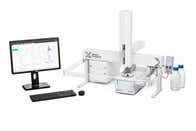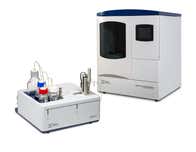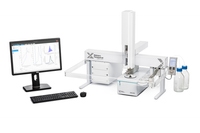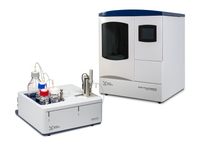
Analysis of the physical and chemical properties of a material using heat
Any instrument that uses the addition or subtraction of heat for monitoring the physical or chemical properties of a sample could be considered a Thermal Analyzer. In this category of scientific instrument, exposure of the sample to a change in temperature can change other physical properties including melting, unfolding, binding, mechanical strength, composition, crystallization or glass transition, rheological properties and much more.
Some Thermal Analysis instruments can monitor the change in temperature of a sample down to 0.000001 °C or less. These subtle changes in temperature can be the difference between for example two folded states of a protein, or the formation of crystal structure and can result in significantly different physical properties including things like stability, toxicity, viscoelasticity, and conductivity.
View the Malvern Panalytical range of microcalorimeters for Thermal Analysis:


| Thermal Analyzer | Abbreviation | Heat Applied or monitored | Property Observed | Derived Properties |
|---|---|---|---|---|
| Differential Scanning Calorimeter | DSC | Applied & Monitored | Temperature |
Melting Point (Tm)
|
| Isothermal Titration Calorimeter | ITC | Monitored | Temperature |
Binding Constant (KD)
|
| Differential Scanning Fluorescence | DSF | Applied | Intrinsic Fluorescence |
Melting Point (Tm)
|
| Thermogravimetric Analysis | TGA | Applied | Sample Mass |
Phase Transition temperature
|
| Dynamic Mechanical Analysis | DMA | Applied | Mechanical Properties | Shear storage and loss moduli (G’, G’’) |
| Thermal Conductivity Analyzer | TCA | Applied | Conductivity | Thermal Conductance |
* When performing an Isothermal Chemical Denaturation experiment


Thermal analyzers have a wide range of applications across various industries, some of which include:





The "Gold Standard" for structural stability analysis of biotherapeutics, b...
Differential Scanning Calorimetry (DSC) is a microcalorimetric technique used to characterize the structural stability of a protein or other biomolecule. It does this by measuring the heat change associated with the molecule’s thermal denaturation when heated at a constant rate.
Theoretically, the higher the thermal transition midpoint (Tm), the more stable the molecule. DSC measures the enthalpy (∆H) of unfolding that results from heat-induced denaturation. It is also used to determine the change in heat capacity (ΔCp) of denaturation. DSC can elucidate the factors that contribute to the folding and stability of biomolecules. These include hydrophobic interactions, hydrogen bonding, conformational entropy and the physical environment.
![[Prod-VP-DSC_1] 636216791199633223AW.png](https://dam.malvernpanalytical.com/38fe5898-2ba2-437e-bb78-ad9e00b154e0/636216791199633223AW_Original%20file.png)

The "Gold Standard" for measuring binding affinity and stoichiometry
Isothermal Titration Calorimetry (ITC) is a label-free quantification technique used in studies of biomolecular interactions. It works by measuring the heat released (exothermic reactions) or absorbed (endothermic reactions) during a binding event.
ITC is the only technique that can simultaneously determine all binding parameters in a single experiment. Requiring no modification of binding partners, either with fluorescent tags or through immobilization, measuring affinity of binding partners in their native state.
Measuring heat transfer during binding enables accurate determination of binding constants (KD), reaction stoichiometry (n), enthalpy (∆H) and entropy (ΔS). This provides a complete thermodynamic profile of the molecular interaction.
![[Techn_ITC_01] 636216611128510007YS.png](https://dam.malvernpanalytical.com/4f7fe1ba-d77e-4ee4-ae6d-ad9d01817c38/636216611128510007YS_Original%20file.png)
Differential Scanning Fluorimetry (DSF) is a fluorescence spectroscopy-based technique that monitors the intrinsic emission spectrum of a protein relative to the applied temperature. During a thermal denaturation process, amino acids that make up a protein are exposed to more hydrophilic environments, causing the maximum signal (λmax) of the intrinsically fluorescent amino acids (Trp, Tyr) to shift from 330 nm to 350 nm. This easily observable signal can then be plotted against temperature, and the second derivative applied to the data to find the thermal transition temperatures (Tm).
Multiple thermal transitions can often occur in a single protein, making this technique highly suitable for monitoring applications such as effect of mutations on protein structural stability, and the effect of buffer composition on protein stability. The technique can even be applied to study binding affinities of low molecular weight ligands, to rank binding affinities of potential drug candidates.

MicroCal DSC rangeThe "Gold Standard" for structural stability analysis of biotherapeutics, biological macromolecules and polymers in solution |

MicroCal ITC rangeThe "Gold Standard" for measuring binding affinity and stoichiometry |
|
|---|---|---|
| Technology | ||
| Differential Scanning Calorimetry (DSC) | ||
| Isothermal Titration Calorimetry (ITC) | ||
| Microcalorimetry | ||
| Measurement type | ||
| Label-free analysis | ||
| Protein stability | ||